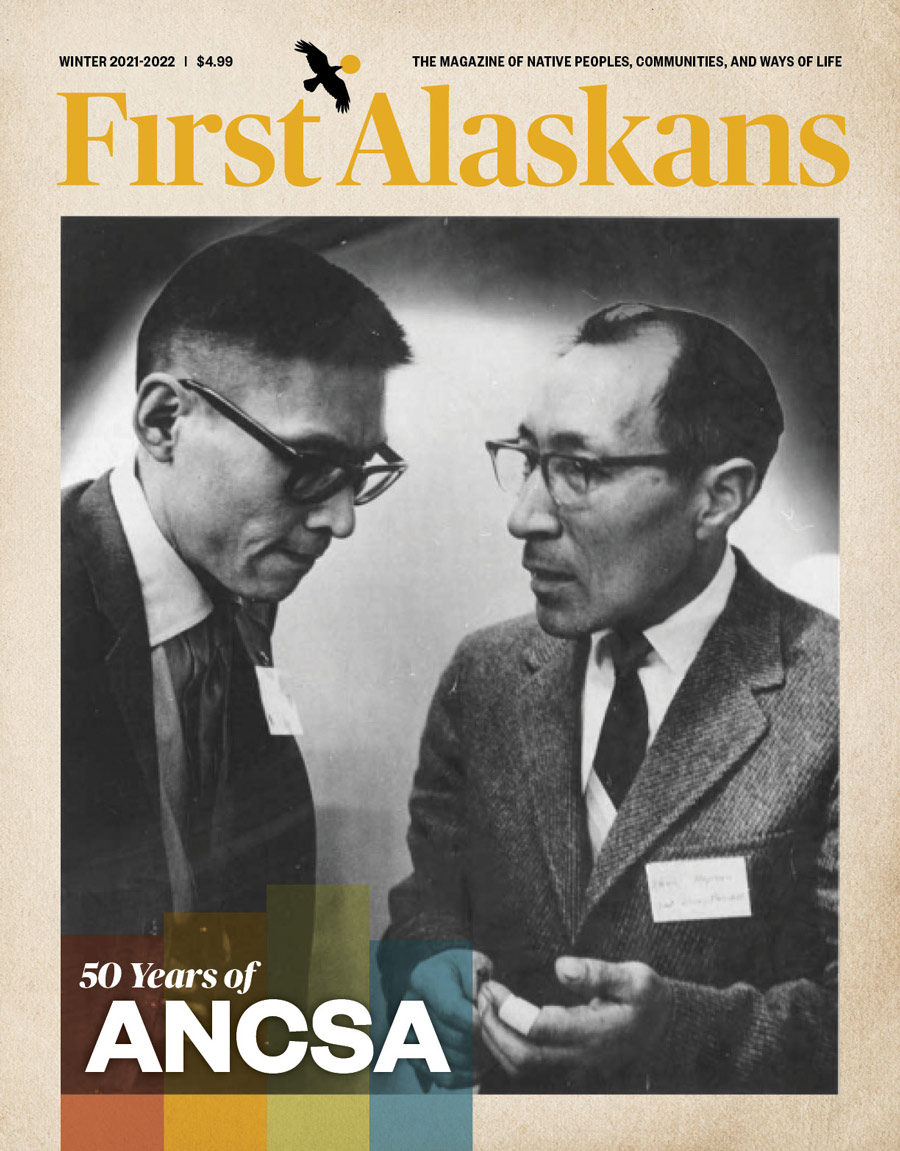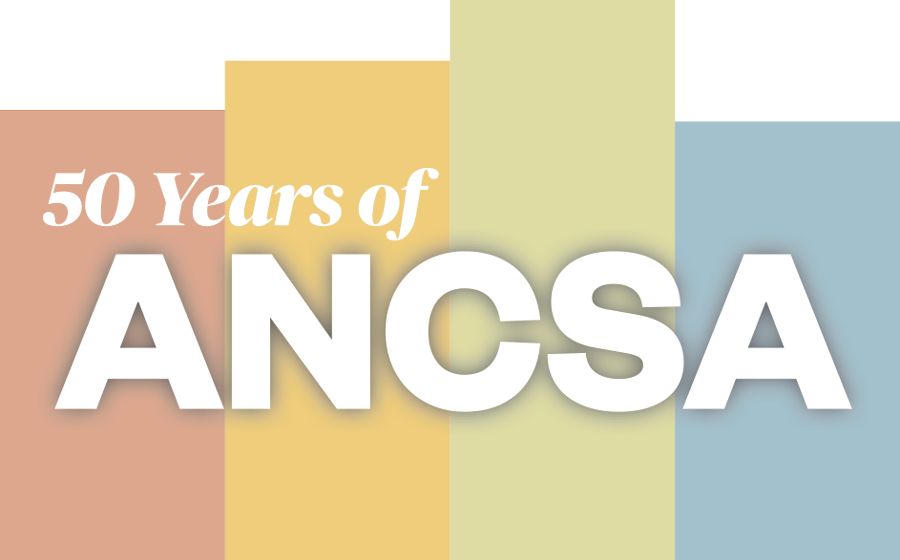


Table of Contents




Section and department titles are in the Deg Xinaq Athabascan language. Each issue of First Alaskans features a different Native language in this role. Thanks to the Deg Xinaq Learner’s Dictionary, published by the Anvik Historical Society.


Side by Side in the Same Direction
The theme for the 2021 Gala was presented in the Eyak language: ahnuu dAXunhyuu AXAkihya’ iLka’ GAdAqeeLinuu (side by side in the same direction, the people go by canoe)—very fitting for uplifting the tremendous work of our awardees for advancing our Alaska Native community. The FAI Trustees and staff were honored to uplift the honorees and their families.
Indigenized
Shopping List

Sinoghł xiłdhoyh  STORIES FROM AROUND
STORIES FROM AROUND
Bill introduced to grant Southeast Native lands
The Sealaska Regional Corporation would maintain sub-surface rights to the land while the village corporations would maintain surface rights, and the bill includes land selections that differ between the U.S. Senate and U.S. House bills. For more, read Alaska Public Media’s coverage.
State of Alaska loses lawsuit challenging hunting rights
“As Alaska Native people, we are only too familiar with the devastation that disease and epidemics can cause to our communities,” said President of the Organized Village of Kake Tribal Council Joel Jackson. “The State of Alaska’s lawsuit is an attack on the right of our people to continue our traditional way of life. Our Tribe is determined to join this lawsuit to defend ourselves and our subsistence way of life.” Learn more from the Native American Rights Fund.

Alaska Native Health Campus launches wayfinding app
“Tinitun” helps campus visitors navigate health campus
he Alaska Native Tribal Health Consortium (ANTHC) and Southcentral Foundation (SCF) have launched Tinitun, a mobile app that helps campus visitors locate providers or clinics with ease, discover campus food options, find the nearest shuttle, mark the location of their parked cars and more. The Tinitun app includes indoor turn-by-turn directions inside the Alaska Native Medical Center (ANMC) hospital, specialty clinics and Anchorage Native Primary Care Center.
Continuity, Renewal, and Joy

Continuity, Renewal, and Joy
or the Nalukataq whaling celebration in Utqiagvik last summer, the Oliver Leavitt Crew (OLC) and families took ten days to make 120 gallons of mikigaq (a fermented whale meat delicacy.) Each bucket had to be stirred at least five times a day to make sure the fermentation process was properly done.
Oliver Aveogan Leavitt has been Umailik (Captain) of his whaling crew since the early 1980s. That responsibility is a big one as he has to insure that the whaling vessel is safe, that the crew is trained, the whaling gun is properly loaded, the harpoons sharp and the ropes strong and properly knotted, and the floats ready. He also has to have enough sleds built to carry the catch home, snow machines maintained and gassed, the tents and stoves ready to use and the proper rifles available in the event polar bears show up. The wife of the umailik, in this instance Annie, is also the backbone of whaling, making sure there is enough food for the crew, that they are clothed and prepared for their vigil on the ice and the water. She makes sure that everything is cut and cooked properly and ensures that there are donut and soup makers. The effort is year round and the real work begins when they tow the agviq (bowhead whale) to the solid ice to be winched up and butchered.
The OLC flag is flown to let the community of Utqiagvik know of the catch and the success of co-captains Alex Kaleak and Avaiyak Burnell. The flag was designed by Oliver’s mother, Mary Lou Leavitt. It features a dark blue background, a center red diamond and two white bands anchoring the four corners. I asked what the symbolism was and gave it my own—white for purity, blue for the ocean and red for the blood vital for all mammals.




Organizing
Up North
his year is the 50th anniversary of the passage of the Alaska Native Claims Settlement Act (ANCSA,) which has changed and benefited all Alaskans in fundamental way. Passed in 1971, the act provided a cash payment and settlement of outstanding claims of Alaska Native people over lands they never ceded to the United States and continued to use for hunting, fishing and other ways of life.
ANCSA’s impact, however, went beyond the cash settlement and the land. It is also linked with the creation of two large regional municipalities, or boroughs, in Alaska—the North Slope Borough in 1972 and Northwest Arctic Borough in 1986.
Those two municipalities, the largest in the U.S by land area, took advantage of the natural resources in their areas, oil for the North Slope and minerals for Northwest Arctic, to bring back self-governance and to revolutionize the lives of people in their areas.

Heading Toward 2071

I. Native Land Claims Era
“They could have claimed ASRC,” she’s said a couple times. She was in kindergarten and one of my Inupiaq names, Iqilan, is after her babysitter of the time. My grandparents knew where they truly came from. “But we’re from the Kobuk River, not the Slope. We only lived there.”
My dad has a similar story, one that recalls how Kotzebue neighborhoods looked before 1971. He’d have been about ten years old. The NANA regional hub town was never a traditional settlement; it was where the surrounding communities went to trade their goods and share their dances every summer. They called the spot Qatnut, a gathering place.


More Than Merely Profit

or Alaska Native corporations (ANCs), developing seafood interests means more than merely making profit; they seek to benefit shareholders and descendants in other ways.
For Bristol Bay Native Corporation (BBNC) and Sealaska, holdings in the seafood industry provide many benefits to their shareholders and descendants. The profits of these business lines offer opportunities for shareholders and descendants such as job search and employment placement assistance, higher education and vocational training, and leadership development/management training programs, to name a few.
The seafood industry is an essential holding for many ANCs as it is an integral part of a diverse portfolio of investments and other business ventures.
Alaska’s ranked-choice system could boost Indigenous voting
laska’s move to a ranked-choice voting system starting with the 2022 elections will give voters a stronger voice in final election decisions and could shift the power base from partisan fringes to moderate voters.
The new balloting system will eliminate partisan primary elections, boosting the chances for middle-of-the-road candidates such as Alaska U.S. Sen. Lisa Murkowski, a moderate Republican who has faced challenges from the right wing of her party.
“More choice, more voice, and more power to voters,” according to a statement by the nonprofit Alaskans for Better Elections on its website.


The
Great
Cedar
Tapestry
(Tsimshian)
the salmon swim upriver depositing their seeds,
they give their life to the forest in an exchange of energy,
the promise of renewal becomes a lasting legacy.
The salmon eggs are kept safe in the waters beneath the trees,
they will hatch and grow, when it’s time they’ll know,
the river will carry them to sea.
Each depends upon the others, a fragile harmony,
each one always giving so that all may receive.
(Tsimshian)
the salmon swim upriver depositing their seeds,
they give their life to the forest in an exchange of energy,
the promise of renewal becomes a lasting legacy.
The salmon eggs are kept safe in the waters beneath the trees,
they will hatch and grow, when it’s time they’ll know,
the river will carry them to sea.
Each depends upon the others, a fragile harmony,
each one always giving so that all may receive.
Reads and Reviews

By William L. Iggiagruk
Hensley (Inupiaq)
Back Cover
Xan’ilił | Imagine
Masthead

Chairman
Sam Kito, Jr. (Tlingit)
Vice Chairman
Valerie Davidson (Yup’ik)
Secretary/Treasurer
Sven Haakanson, Jr. (Sugpiaq)
Albert Kookesh (Tlingit)
Sylvia Lange (Aleut/Tlingit)
Oliver Leavitt (Iñupiaq)
Georgianna Lincoln (Athabascan)
Morris Thompson (Athabascan)
In Memoriam
(Haida/Tlingit/Ahtna)
Alaska Native Policy Center Director
Karla Gatgyedm Hana’ax Booth (Ts’msyen)
Indigenous Leadership Continuum Director
Melissa Silugngataanit’sqaq Borton (Sugpiaq), Indigenous Advancement Director
Eliabeth Uyuruciaq David (Yup’ik)
Financial Director
Angela Łot’oydaatlno Gonzalez
(Koyukon Athabascan)
Indigenous Communications Manager
Indigenous Knowledge Advocate
Colin Tass’aq McDonald (Yup’ik)
Indigenous Advancement Manager
Elizabeth La quen naáy / Kat Saas
Medicine Crow (Tlingit/Haida)
President/CEO
Ayyu Qassataq (Iñupiaq)
Vice President
& Indigenous Operatons Director


Anchorage, AK 99501
advertising@firstalaskans.org
First Alaskans Magazine is published by
First Alaskans Institute. © 2021.
(Tlingit/Dena’ina Athabascan)
(Tlingit/Inupiaq)
Ayyu Qassataq (Inupiaq),
Richard Perry (Yup’ik/Athabascan),
Erin Tripp (Tlingit),
Willie Iggiagruk Hensley (Inupiaq),
Jacque Lambert (Inupiaq)



